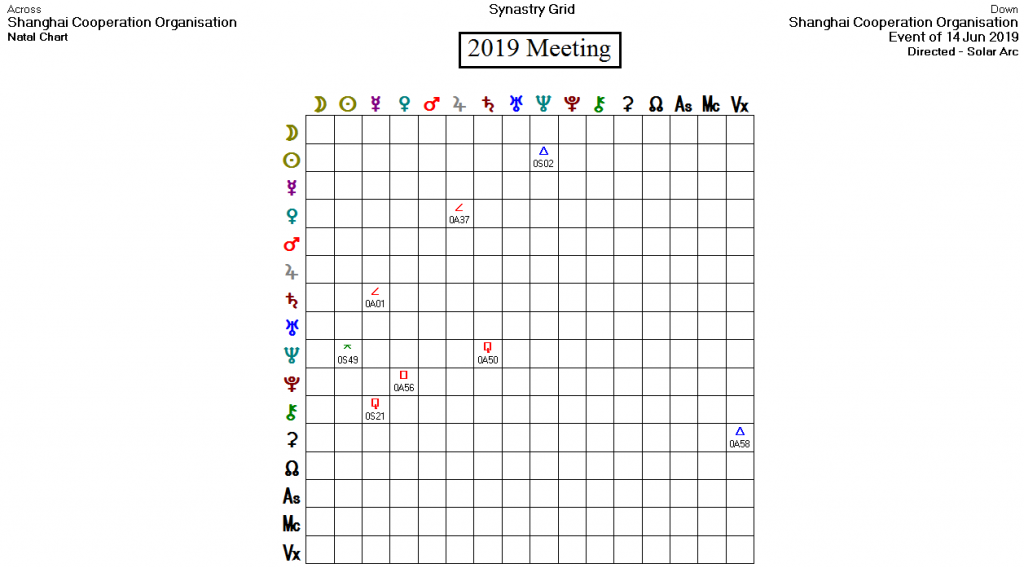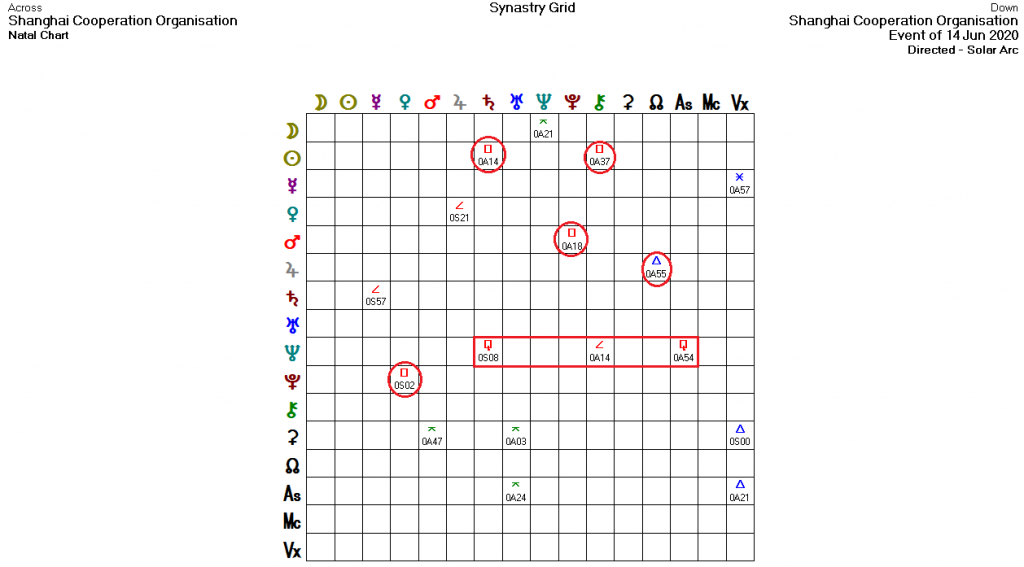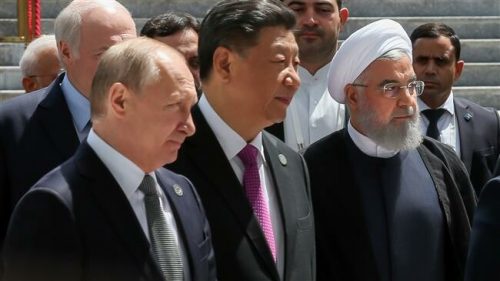(This post follows on a bit from the previous one, about why war with Iran is off the table) The 2019 meeting of the Shanghai Cooperation Organisation (SCO) was just held in Bishkek, Kyrgyzstan. It is an organization that covers nearly half of the world’s population and 3/5 of the Eurasian landmass. The organization was announced on 15 June 2001 in Shanghai, China by the leaders of China, Kazakhstan, Kyrgyzstan, Russia, Tajikistan, and Uzbekistan, but entered into force on 19 Sep 2003. Since then it has expanded to include India and Pakistan. In addition, Belarus, Mongolia, Afghanistan and Iran all have observer status. Observer states have the option of applying for full membership. Needless to say, the SCO represents a problem for the West, especially Washington, since they were denied observer status.
The chart for the SCO is below (bigger):

The SCO was founded because of security concerns, primarily, especially with the threat of terrorism arising in the Caucasus and Xinjiang regions. Russia and China were the main drivers for the organization. The stated purpose is to promote cooperation for security against terrorist threats and ‘external threats’. We have an idea of what the latter infers. The members have conducted regular joint military drills to promote cooperation and integration. Both China and Russia have real concerns regarding those security interests. In the chart those concerns are illustrated by the Cancer Ascendant with Saturn close behind in the 12th house (concerns about foreign enemies of the state, or region in this context). Ceres is also conjunct the Ascendant and Saturn in the 1st house, indicating the nurturing aspect of the organization, as well as its marking a turning point in the world security matrix.
Security issues are also indicated by the fourth house, planets therein and the ruler of the cusp. Virgo and Mercury rule the 4th house of this chart, and we find the Sun on the cusp in that house. Libra is in the 4th house, ruling Libra, which is intercepted in that house. Mercury, ruler of the house, is sextile Saturn, marking a real depth of thought, with slow and steady progress in implementation. There is a fly in the ointment with that, though, with Neptune forming a yod and thus a strong midpoint, Neptune=Mercury/Saturn. This gives, “a state of depression, distrust and emotional inhibitions”. In the case of a security organization this can actually be a help, as it gives a sense of ‘hope for the best, expect the worst’ in terms of planning. At its worst it gives a sense of paranoia. But given the present state of world affairs such paranoia can perhaps be forgiven.
Neptune also forms the apex of a ‘finger of the world’ configuration with the base Sun/Moon square. The square gives the ability to live by one’s wits and objectifies the desires, giving a quick response to any presented situation. But with the Neptune apex the possibility exists for delusions to creep in, along with mistakes and misunderstandings. A good example of that possibility is the recent switch in the attitude of Modi in India toward the US-led ‘Quad’ since his reelection. It makes one wonder if he perhaps owes someone something for his recent reelection, speaking of paranoia. India recently stopped importing oil from Iran under pressure from the US, and India was Iran’s second-biggest customer.
Continuing with the chart, though, the tendency toward paranoia and misunderstandings is offset to a degree by the Neptune trine from Venus from the 4th house, marking a powerfully idealistic and magnetic influence. Venus forms one point of the base of a quintile triangle, the other being the Mars/Uranus conjunction in the 9th house (foreign affairs and trade, international relations), marking a very tough and independent foreign policy, a brutal frankness, ready to take on all comers. The apex of that triangle is Pluto. This makes for a powerfully creative partnership between those nations and a generally excitable attitude towards undertakings.
Pluto is in the 6th house (services and military) conjunct the cusp of that house, further highlighting security concerns. Lastly, we cannot leave out Jupiter. It is in the 3rd house (communications, siblings, internal transport and trade) opposite the Mars/Uranus conjunction. The combination gives great good fortune, but also risk-taking behavior, successful tests of strength and luck when least expected. This preview takes us to the latest meeting.
There were obvious tensions between certain member states at the latest meeting. Modi of India and Imran Khan of Pakistan refused to shake hands at the meeting, or hold talks. India shunned a meeting at the last minute with Iran, which was a poor move on Modi’s part. Modi has problems with China’s Belt and Road Initiative (BRI), mostly related to Pakistan. This goes back to the Neptune in the SCO chart. It also shows in the directions to the organization, shown below (bigger):

We see a direction of Saturn to Mercury, curtailing communications, which was pretty well exact on the days. The sticking point is Kashmir. China has invested heavily in Pakistan, especially in the Gwadar port and the transport corridors leading to it. Its BRI passes through Pakistani Kashmir. Mercury is in the 3rd house of the SCO chart. That there are tensions now between members over transport corridors comes as no surprise. China and India can probably work out their differences, but the Kashmir problem needs serious attention. There was almost a war there a few months ago.
And as to India’s shun of Iran, that can probably be directly traced to US pressure. That, too, is easy to see, as Iran forms a key hub in China’s BRI, which Washington is seeking to disrupt. China and Iran held meaningful talks at the SCO. But there is something more to it. Iran is looking to become a full member of the SCO this year in all likelihood, along with Turkey, possibly. That would sew up the Central Asian region and be a hedge against Western designs for the region. It would also serve to keep the West out of Mackinder’s ‘heartland’, which is a prize the US has been seeking for some time. It has also been a pet project of many Bilderberg types – i.e. Atlanticists.
Iran has double trouble because of its geographic position, its size and its politics. Since it is a key part of China’s plans for the future, and Russia’s too, it faces pressure from the US to come onside and orient itself with the West, which would take it away from China’s orbit. That was part of the reason for the JCPOA, because it brought Iran closer to the West. On the other hand it faces problems with Israel and Saudi Arabia, both because of its Shia population and the size of its energy reserves, and because Iran has called for the government of Israel to be removed from the face of the Earth. And then, Russia and Iran have clashing interests and are competitors for energy sales, but Russia depends on Iran for security. The situation has been summarized as follows:
“Iran is at the heart of the BRI-SCO-EAEU integration road map – the nuts and bolts of Eurasian integration. Russia and China cannot allow Iran to be strangled. Iran boasts fabulous energy reserves, a huge internal market, and is a frontline state fighting complex networks of opium, weapons and jihadi smuggling – all key concerns for SCO member states.”
So, it is probably only a matter of time before Iran joins the SCO. For its part, China has been drawing quite close to Iran. And it does look like there will be new members in the near future, given the direction of Venus to the SCO Jupiter. To that we can also add the direction of Pluto to the SCO Venus. If/when that were to happen, then any dreams by Washington and the West of dominating Central Asia would be dead. And if Turkey then joins, well the region will take a dramatic turn, away from the West.
Iran put on its own charm offensive at the SCO. The Organisation is more than a simple security cooperative. There are also political and economic interests. Given Iran’s new domestic and foreign policy strategy, they invited all the members of the SCO, saying they were, “ready to provide all the benefits for the economic activities of citizens, companies and governments of this organization [SCO] in Iran…” There is a large consensus among members that Iran should be a part of the SCO. And for the 2020 conference? The directions to the SCO chart tell again that they will be going forward ambitiously. The directions are below (bigger):

The circled directions show ambition, movement forward, aggressive pursuit of plans and possible new contacts. The direction of Neptune in the boxed area shows possible separations due to disagreements, or at least a more depressing environment. We’ll have to wait and see what is going on at that point in the world, as it is far too early to tell what that might be. Iran might be facing a leadership spill around that time. But that’s another story. This is one organization that needs watching, though, because many keys to the world’s future are working out there.
Featured pic from Press TV

